Blairgowrie and Rattray
Blairgowrie and Rattray (/blɛərˈɡaʊri ... ˈrætreɪ/ (![]()
Blairgowrie
| |
|---|---|
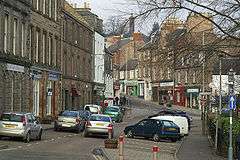 Blairgowrie town centre | |
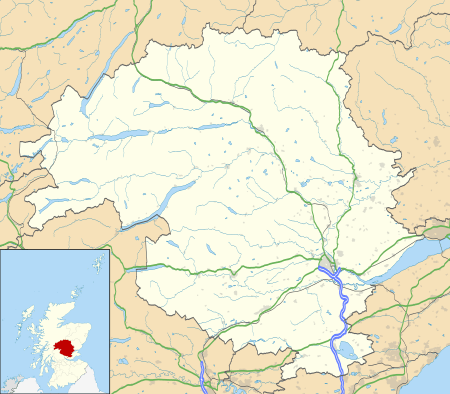 Blairgowrie Location within Perth and Kinross | |
| Population | 7,965 [1] (2001 census) est. 9,060[2] (mid-2015) |
| OS grid reference | NO178452 |
| • Edinburgh | 44 mi (71 km) |
| • London | 375 mi (604 km) |
| Council area | |
| Lieutenancy area | |
| Country | Scotland |
| Sovereign state | United Kingdom |
| Post town | BLAIRGOWRIE |
| Postcode district | PH10 |
| Dialling code | 01250 |
| Police | Scotland |
| Fire | Scottish |
| Ambulance | Scottish |
| UK Parliament | |
| Scottish Parliament | |
The name
The name Blairgowrie means "Plain of Gowrie" in Scottish Gaelic, in which language it is spelt Blàr Ghobharaidh[3][4][5][6] or Blàr Ghobhraidh.[7] The name Rattray is Raitear in Gaelic, and may derive from an English language cognate of Gaelic ràth meaning "fortress" plus a Pictish term cognate with Welsh tref meaning "settlement".
History
Early history
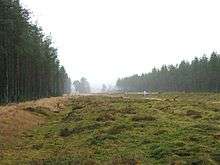
The area around Blairgowrie has been occupied continuously since the Neolithic, as evidenced from the Cleaven Dyke, a cursus monument 2 miles (3 kilometres) south-southwest of the town,[8] as well as a Neolithic long mortuary enclosure 4 miles (6 kilometres) west-southwest at Inchtuthil.[9] Several stone circles of this age can also be found in the area, notably the circle bisected by the road at Leys of Marlee, 1 mile (1.5 kilometres) west of Blairgowrie.[10]
Numerous Neolithic and Bronze Age artifacts have been found in the immediate area, including a number of flint arrowheads, spearheads, knives and scrapers found at Carsie, 1⁄2 mile (800 metres) south of Blairgowrie, and which are now displayed at Perth Museum,[11] and bronze axes,[12] and a bronze sword now in Kelvingrove Museum, Glasgow.[13]
The remains of a Roman legionary fort can be found 4 miles (6 kilometres) west-southwest of Blairgowrie at Inchtuthil, dating from the decade 80-90. Unencumbered by subsequent development, this is considered to be one of the most important archaeological sites in Britain.[14]
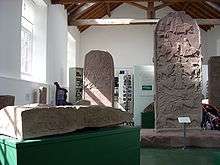
Pictish remains are in abundance in this part of Scotland and one of the largest collections of Pictish sculptured stones is housed 5 miles (8 kilometres) east of the town at the Meigle Sculptured Stone Museum. The size of the collection, all of which were found in Meigle, suggests this was an ecclesiastical centre of some importance in the 8th to 10th centuries.[15]
Modern history
From around 1600 to the beginning of the 19th century, Blairgowrie had a fairly stable population, recorded at 425 inhabitants in the first Statistical Account in 1792. The second Statistical Account of 1853 notes a disproportionate increase due to an influx of families attracted by the expanding textiles industry.[16] Gaelic was declining but still partially spoken in the upper part of the parish at that time, with all speaking English.
Blairgowrie was made a barony in favour of George Drummond of Blair in 1634 by a royal charter of Charles I, and became a free burgh in 1809. In 1724 the military road from Coupar Angus to Fort George which passes through the town on the line of the A923 and A93 was completed.
The town expanded hugely in the 19th century thanks to the employment provided by the many textile mills which were built along the River Ericht, all now closed. By 1870 there were 12 mills along the river employing nearly 2,000 men and women and the population had increased from 400 in the 1700s to 4,000. The disused mill buildings can be seen from the riverside walk west from the bridge and from Haugh Road to the east . Keithbank Mill has been converted to apartments.
Soft fruit growing, mainly raspberries and strawberries developed in the 20th century and became a very important part of the town's economy with Smedleys opening a cannery in Haugh Road, Adamsons a jam factory in Croft Lane and huge quantities of table berries and pulp being despatched to markets and jam factories throughout Britain. Berry pickers were brought in by bus from Perth and Dundee, and large encampments were set up on farms for pickers from further afield, mainly from the Glasgow area, who made this their annual holiday. They were joined by the travelling community who congregated here for the berry season. One of the best examples was the Tin City at Essendy, which housed workers in a complex of tin huts with its own chapel, post office, shop, kitchens, etc. The Tin City has gone but now every fruit farm has an extensive well appointed caravan site to house the hundreds of Eastern European students who arrive every summer to pick the fruit.
The coming of the railway revolutionised the textile and soft fruit trade, but the last train ran in the 1960s, and the extensive railway yards are now the site of the Tesco supermarket and Welton Road industrial estate.
Blairgowrie had a busy livestock market at the bottom of the Boat Brae but this closed in the 1960s and is now the site of the Ashgrove Court sheltered housing complex.
Blairgowrie and Rattray Districts Cottage Hospital opened in May 1901, but its foundation can be traced back to 1882 when the idea for such a hospital was put forward by Mrs Clerk-Rattray. On her death she bequeathed £25 which was to be given to such an institution if it was ever founded. However attempts over the next few years to raise subscriptions to found the hospital failed. Eventually land for a hospital was gifted by Mrs Macpherson of Newton Castle and subscriptions were raised to found the hospital. As well as these monetary donations, furnishings for the hospital were provided while the architect Lake Falconer took no fee for his work on the hospital. At the time of opening it had two large wards.[17] It is now known as Blairgowrie Community Hospital.[18] In 2014 a £2.36 million refurbishment project saw the development of a purpose built in-patient GP unit and other new units added to the site.[19]
A short distance upstream from the bridge on the riverside path is Cargill's Leap, a historic site where Donald Cargill, a minister and covenanter, escaped Government troops by jumping over the rocky gorge of the River Ericht.
Just outside the Rattray boundary on the A93 is Craighall Castle, the ancestral home of the chieftain of the Clan Rattray. The castle occupies a dominating position on the edge of the gorge above the river but unfortunately is no longer occupied by a Rattray, having been sold in 2010.
Newton Castle, home to the current chieftain of the Clan Macpherson, Sir William Macpherson, and Ardblair Castle, home to the Blair Oliphant family, both have Jacobite history and according to legend are connected by a secret tunnel.
Climate
Blairgowrie has an oceanic climate (Köppen: Cfb).
| Climate data for Blairgowrie (79 m or 259 ft asl, averages 1981–2010) | |||||||||||||
|---|---|---|---|---|---|---|---|---|---|---|---|---|---|
| Month | Jan | Feb | Mar | Apr | May | Jun | Jul | Aug | Sep | Oct | Nov | Dec | Year |
| Average high °C (°F) | 6.0 (42.8) |
6.6 (43.9) |
8.8 (47.8) |
11.6 (52.9) |
14.9 (58.8) |
17.6 (63.7) |
19.4 (66.9) |
18.9 (66.0) |
16.0 (60.8) |
12.3 (54.1) |
8.7 (47.7) |
6.1 (43.0) |
12.2 (54.0) |
| Average low °C (°F) | −0.2 (31.6) |
0.4 (32.7) |
1.5 (34.7) |
3.3 (37.9) |
5.7 (42.3) |
8.5 (47.3) |
10.4 (50.7) |
10.2 (50.4) |
7.7 (45.9) |
5.2 (41.4) |
2.4 (36.3) |
−0.3 (31.5) |
4.6 (40.2) |
| Average rainfall mm (inches) | 78.5 (3.09) |
57.0 (2.24) |
59.6 (2.35) |
45.9 (1.81) |
56.4 (2.22) |
58.7 (2.31) |
73.0 (2.87) |
83.1 (3.27) |
75.2 (2.96) |
85.4 (3.36) |
74.3 (2.93) |
72.5 (2.85) |
819.6 (32.26) |
| Average rainy days (≥ 1 mm) | 14.6 | 10.1 | 11.3 | 8.4 | 10.6 | 10.5 | 11.2 | 12.4 | 10.8 | 13.4 | 12.1 | 12.3 | 137.7 |
| Mean monthly sunshine hours | 51.7 | 74.6 | 114.4 | 154.9 | 180.4 | 156.8 | 159.4 | 154.5 | 122.2 | 89.3 | 63.9 | 35.0 | 1,357.1 |
| Source: Met Office[20] | |||||||||||||
Economy
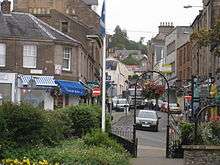
The surrounding area is still the soft fruit centre of Scotland, and the local population increases greatly in summer when the Eastern European students arrive to harvest the fruit which traditionally consisted of raspberries and strawberries but now includes a wider range with cherries, blackberries, blueberries, gooseberries etc. The extensive use of poly tunnels and raised beds has greatly extended the growing season with fruit available from May until October.
Other major industries include Castle Water, Proctor Insulation, Tayside Contracts, Graham Environmental, Davidsons chemist headquarters and various fruit processing and freezing plants. The thriving industrial estate on Welton Road is home to many small businesses.
The town has two main motor dealerships, Balmoral Garage who are Ford dealers and Norman Laing who supply Peugeot plus several independent garages.
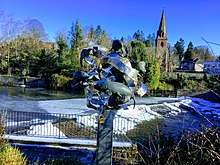
The local weekly newspaper is the Blairgowrie Advertiser, locally known as "the Blairie", which is now produced and printed in Perth by Trinity Mirror Group. The Blairie has a long history and was originally produced and printed in the old printworks in Reform Street where the original print machines are still mothballed.
There are regular Saturday outdoor markets in the Wellmeadow with stalls offering local produce and crafts.
Blairgowrie has a thriving town centre with an unusually wide range of independent shops, craft workshops, restaurants and pubs. National retailers include Tesco, Sainsbury's, Co-op, M&Co and The Angus Hotel and Royal Hotel cater for local customers, tourists and a large number of bus parties who find the town an ideal touring base.

Education
The new Blairgowrie Campus opened in Elm Drive in 2009 incorporating Newhill Primary and St Stephens RC Primary. Newhill primary holds about 360 children while St Stephens RC primary is a smaller unit holding about 70 pupils. Rattray Primary serves children on that side of the river. Blairgowrie High School in Beeches Road provides secondary education for all round the area. The adjacent Recreation Centre has a pool and leisure facilities and is scheduled for replacement in the near future. The disused former Hill Primary School was the subject of a controversial but ultimately unsuccessful attempt by The Ericht Trust to provide a community centre but it has now been sold for conversion to housing as has the former St Stephen's RC primary school in John Street.
Public transport
Stagecoach provide all the bus services to and from Blairgowrie with routes to Perth, Dundee, Alyth, Coupar Angus, Dunkeld, Aberfeldy, Kirkmichael and Glenshee as well as a circular town service. The nearest railway stations are Perth and Dunkeld & Birnam and the nearest airport is Dundee. Services to Perth and Dundee are frequent. The bus station is located in the Wellmeadow.
Churches
Churches represented are Church of Scotland (Blairgowrie and Rattray Parish Churches), St Stephen's RC, St Catherine's Episcopalian, Evangelical Church, Church on the Way, Lifeplus Church, Methodist Church and Plymouth Brethren.
Culture
In 1996, Blairgowrie hosted the Royal National Mòd, a festival of the Scottish Gaelic language.[21] Since then the town has featured bilingual street signs, in English and Gaelic.
Notable people
- Hamish Henderson (1919-2002), poet, folk singer and activist, born in Blairgowrie
- Prof Robert Alexander Robertson FLS FRSE (1873-1935), botanist, born in Rattray
- Lt Col Alexander Dron Stewart FRSE (1883-1969), born in Blairgowrie
- Alan Gifford (1911-1989), American-born film and television actor, died in Blairgowrie
- Jake Findlay (1954- ), professional footballer, most notably for Luton Town F.C., born in Blairgowrie
Sport
Football
Blairgowrie and Rattray is home to the Scottish Junior Football East Region Premier League side Blairgowrie F.C. as well as the Scottish Amateur Football Association sides Rattray A.F.C. and Balmoral United A.F.C. which play in the Perthshire Amateur League.

Rugby
Blairgowrie Rugby Club was founded in 1980 (originally as Blairgowrie High School FP RFC) and as of 2019, plays in the Caledonia Regional League Caledonia League 1. The team is based within the John Johnston Coupar Recreational Park on Coupar Angus Road, which formed part of an old berry farm which was bequeathed to the town in the 1970s for use as a sports and recreational facility.
Golf
Blairgowrie Golf Club was founded in 1889. There are now two 18-hole courses, Rosemount and Lansdowne, and a 9-hole course.
Skiing
The Glenshee Ski Centre in Glenshee (Scottish Gaelic: Gleann Sith, "Glen of the Fairies"), is some 18 miles (29 kilometres) north at the Cairnwell Pass on the A93 Braemar road, which is the highest public road in the UK.
Hillwalking
Blairgowrie is normally considered the start and finish of the marked 64-mile (103-kilometre) Cateran Trail long-distance walk which follows a circular route through Glenericht and Strathardle to Bridge of Cally, Kirkmichael and Enochdhu, over Ben Earb to Spittal of Glenshee, through Glenshee and Glenisla to Kirkton of Glenisla and Alyth and finally back to Blairgowrie. The trail is divided into five stages and can easily be walked in five days or less, although winning teams in the annual "Cateran Yomp" regularly complete it in under eleven hours.
Rattray
The traditional ball game of Rattray no longer takes place, but the Rattray silver ball, the trophy retained by the winners, is still in existence. It is believed to have been donated by Sylvester Rattray of Nether Persie who became minister of Rattray in 1591 and continued there until his death in 1623.[22] The Rattray silver ball is now kept at Perth Museum and Art Gallery.[23]
Highland Games
Blairgowrie Highland Games are held annually on the first Sunday of September in Bogles Field on Essendy Road. It is noted for its Hill Race and its mass tug o'war where as many contestants as possible from Blairgowrie and Rattray compete against each other.
The evening before is known as Braemar Night with entertainment in the Wellmeadow and fireworks along the river. This tradition started in the 1960s to encourage travellers returning from the Braemar Highland Games (then held on a Thursday), which attracted huge numbers of visitors due to the attendance of the Royal Family, to stop in the town and quickly grew into a huge programme of entertainments, pipe bands, fireworks, funfairs etc., drawing tens of thousands not only returning south from Braemar but on special excursions from Perth and Dundee.
When Blairgowrie Games restarted in the 1980s, the Braemar Games had moved to the first Saturday in September, and the following day seemed an appropriate date for Blair Games. Braemar Night has evolved into a more refined smaller all-day event aimed at locals but is still extremely popular. The main feature and finale is a spectacular firework display along the River Ericht which draws large crowds onto the bridge, which is temporarily closed, and along the riverside areas.
"Snow Road" Blairgowrie is the southern point of the Cairngorm National Park Snow Road tourist route which runs through Glenshee, Braemar, Ballater and Tomintoul to its northern end at Grantown-on-Spey. The route includes the highest point on the UK road system at the Cairnwell Pass and the Cockbridge to Tomintoul road over the Lecht Pass which is well known on winter road reports as one of the first to be closed by snow.
Namesakes
Blairgowrie, a suburb of Melbourne, Victoria, Australia, and Blairgowrie, a suburb of Johannesburg, South Africa were named after the town.
See also
References
- "Comparative Population Profile: Blairgowrie Locality". Scotland's Census Results Online. 29 April 2001. Archived from the original on 22 March 2012. Retrieved 31 August 2008.
- "City Population: Localities: The population of all localities in Scotland with 500 inhabitants or more". Retrieved 12 May 2017.
- Iain Mac an Tàilleir. "Placenames" (PDF). Scottish Parliament. Retrieved 28 November 2011.
- "Blàr Ghobharaidh - Fiosrachadh Meòire". An Comunn Gàidhealach. Retrieved 28 November 2011.
- "I'm No Comin Oot the Noo (and 379 others)". Tobar an Dualchais. Retrieved 28 November 2011.
- "Am Mòd Nàiseanta - Ionadan gach bliadhna". Sabhal Mòr Ostaig. Retrieved 28 November 2011.
- "Database". Ainmean Àite na h-Alba. Retrieved 28 November 2011.
- Barclay, G; Maxwell, G.S. (1998), The Cleaven Dyke and Littleour: monuments in the Neolithic of Tayside, Society of Antiquaries of Scotland Monograph Series, Kings Stanley, Gloucestershire: Past Historic, retrieved 2 December 2009
- Barclay, G.J.; Maxwell, G.S.; Mills, C. (2002). "Excavation of a Neolithic long mortuary enclosure within the Roman legionary fortress at Inchtuthil, Perthshire" (PDF). Proceedings of the Society of Antiquaries of Scotland. 121: 27–44. Retrieved 3 December 2009.
- Coles, F.R. (1909). "Report on stone circles surveyed in Perthshire (Southeast district), with measured plans and drawings obtained under the Gunning fellowship" (PDF). Proceedings of the Society of Antiquaries of Scotland. 43: 93–130. Retrieved 2 December 2009.
- Canmore database, Carsie, Royal Commission on the Ancient and Historical Monuments of Scotland, retrieved 3 December 2009
- Cowie, T; Reid, A. (1986). "Some recent finds of Bronze-Age metalwork from Perthshire" (PDF). Proceedings of the Society of Antiquaries of Scotland. 116: 69–88. Retrieved 2 December 2009.
- Coles, J.M. (1959). "Scottish Late Bronze Age Metalwork: Typology, Distributions and Chronology" (PDF). Proceedings of the Society of Antiquaries of Scotland. 93: 16–134. Retrieved 2 December 2009.
- Breeze, D.J. (2002), Roman Forts in Britain (2 ed.), Princes Risborough, Buckinghamshire: Shire Publications, archived from the original on 14 November 2012, retrieved 3 December 2009
- Ritchie, A (1989), Picts: An Introduction to the Life of the Picts and the Carved Stones in the Care of the Secretary of State for Scotland, Edinburgh: HMSO Publications
- McDonald, R. (1843), "Parish of Blairgowrie", The new statistical account of Scotland, 10, pp. 897–933, retrieved 3 December 2009
- "THB 34 Blairgowrie and Rattray Districts Cottage Hospital". Archive Services Online Catalogue. University of Dundee. Retrieved 17 November 2017.
- "Blairgowrie Community Hospital". NHS Tayside. Retrieved 17 November 2017.
- Lowson, Alison (15 April 2014). "£2m works begin at Blairgowrie hospital". Daily Record. Retrieved 17 November 2017.
- "Blairgowrie (Perth and Kinross) UK climate averages". Met Office. Archived from the original on 20 March 2020. Retrieved 20 March 2020.
- "Mod News: Royal Seal of Approval". 1 October 2010. Retrieved 21 September 2011.
- Perthshire Diary - The Rattray silver ball - January 30th 1623
- Silver ball of Rattray
- "Pleasanton - Blairgowrie - Fergus Sister City Organization". Retrieved 4 February 2007.
External links

- Blairgowrie & Rattray Community Website
- Blairgowrie, Rattray & East Perthshire Tourist and Visitor
- Blairgowrie & East Perthshire Tourist Association Website
- Blairgowrie & Rattray Community Council Information Guide
- Chisholm, Hugh, ed. (1911). . Encyclopædia Britannica. 4 (11th ed.). Cambridge University Press.
| Wikivoyage has a travel guide for Blairgowrie & Rattray. |